Daylily: description of species and varieties, growing secrets
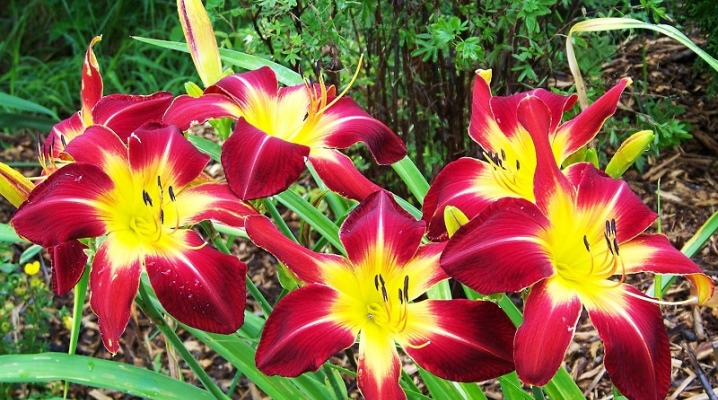
Daylilies are amazingly beautiful representatives of the world of decorative flora, capable of becoming a bright decoration of any backyard territory. These spectacular and rather unpretentious perennials are rightfully popular both among inexperienced amateur flower growers and among experienced gardeners. What are the nuances to consider when growing and breeding daylilies? How should you care for them? In what ways can these flowers be propagated? Answers to these and many other questions can be found in this article.
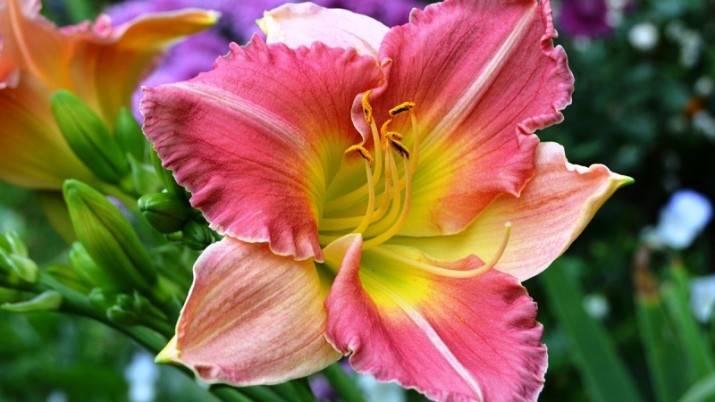
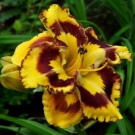
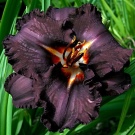
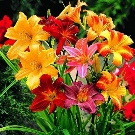
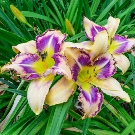
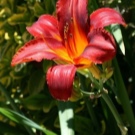
Main characteristics
Daylily is a genus of flowering perennial plants of the Asphodellaceae family. Their other name - "krasodnevy" - these perennials received due to the very short life span of their blossoming flowers. So, in most species of daylilies, spectacular funnel-shaped flowers delight with beauty for just one day. But due to the fact that wilted flowers are immediately replaced by new ones, the flowering of the plant seems lush and continuous.
The roots of krasodnev are strong, strong, thick. This structure of the root system allows plants to tolerate moisture deficit in the soil during drought periods. Leaves are long, xiphoid, moderately wide, with a pointed tip. Even in the period when the daylily is not yet blooming or has already faded, the compact rosettes of its leaves look very attractive.

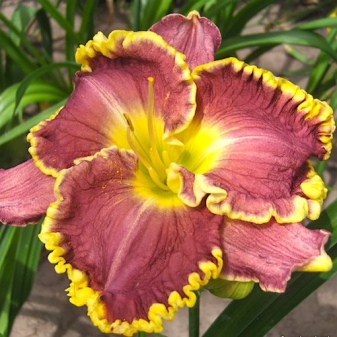
The average height of an adult plant can vary from 50 to 120 centimeters. To date, breeders have bred both dwarf and medium- and tall varieties of daylilies. Krasodneva flowers outwardly resemble lily flowers. Their shape, size and color depend on the varietal characteristics of the plant. During flowering, daylilies form long peduncles, on each of which 2-3 buds open daily. In total, up to 40-50 buds can form on one peduncle.
The average duration of blooming is 25-30 days. Some varieties are capable of blooming twice in one season.
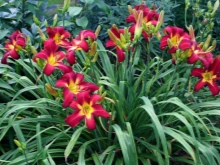
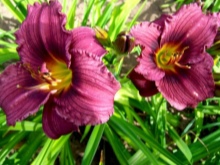
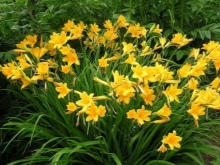
The fruits of krasodnev are small leathery capsules filled with few seeds. It should be noted that many wild daylilies reproduce aggressively by self-sowing, re-pollinate, independently forming interspecific hybrids. The cultivated varieties of daylilies often do not form seeds. For this reason, in breeding work, their seeds are obtained using artificial pollination.
The color palette of daylilies is unusually diverse. So, in modern gardens you can find one-, two- and even tricolor varieties of krasodnev. Plants with contrasting colors (burgundy-yellow, beige-cherry, coral-purple) look very impressive. The most common daylilies are yellow, pink, purple, red and cream colored.
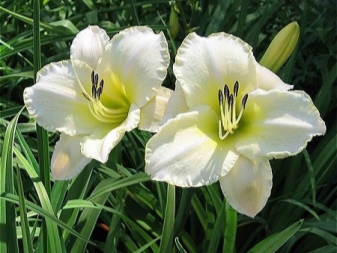
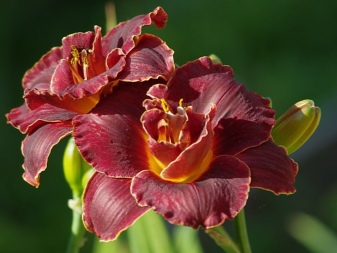
Flowers in most species of daylilies are large enough (about 15 centimeters in diameter), funnel-shaped, star-shaped or bell-shaped. Depending on the structure and shape of flowers, it is customary to distinguish between krasodnye having:
- simple single (Single group) and double (Double group) flowers;
- flowers of the original form (group Unusual Form or UFO);
- arachnid flowers with petals 4 times as long as wide (Spider group);
- multi-petalled flowers (group "Polymers").

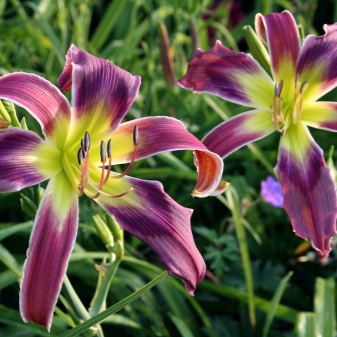
There is also a group called "Multiform"... The flowers of daylilies belonging to this group, in their appearance, combine at least 2 signs of flowers from other groups (terry arachnids, terry unusual shapes, multi-petal arachnids).
Depending on the duration of the growing season (the period of the most active development), it is customary to divide Krasnodnya into the following groups:
- deciduous (dormant and dormant);
- evergreen.
Plants belonging to the first group, before wintering, completely or partially lose their foliage. At about the beginning or mid-September, their aboveground part dies off, and the plant stops developing and growing. All life processes resume with the arrival of spring, when the temperature of the air and soil begins to rise.
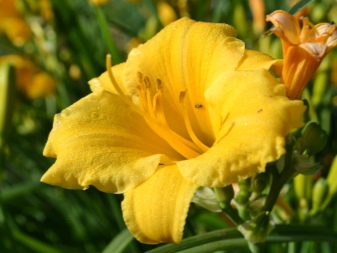
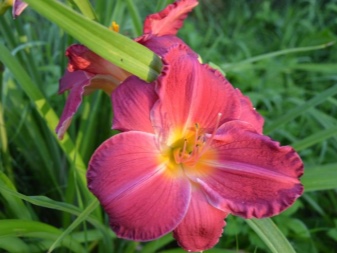
Plants belonging to the second group retain their foliage all year round. Most of the members of this group are intended for cultivation in tropical and subtropical climates.
There is also an intermediate group - semi-evergreens. In this category, experts include hybrids, the behavior of which can carry the features inherent in plants from the two previous groups. So, when growing in a mild and warm climate, the growing season in daylilies of this group can persist throughout the year. Their foliage remains green even in winter, and growth and development occur almost continuously.
However, when grown in a temperate climate, such hybrids can stop growing, partially or completely shedding foliage and going into a dormant phase with the onset of stable cold weather.

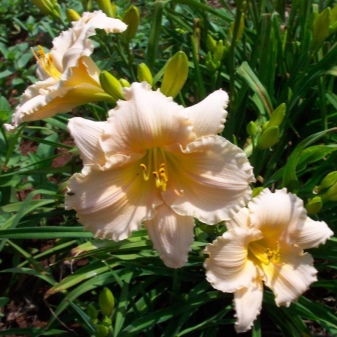
Overview of the species and the best varieties and their shades
The varietal variety of daylilies is amazing. So, professional flower growers claim that to date, breeders have bred more than 70 thousand varieties of these flowering plants. Below are the most popular varieties and types of krasodnev that are widespread in landscape design.
"Tiger Blood"
A very effective and hardy variety of daylilies with large (about 15 centimeters in diameter) flowers. The average plant height is 70-80 centimeters. The color of the flowers is lemon yellow, with a large purple-violet spot in the center. The edging of the corrugated petals is purple-violet. The flowering period is June-July.
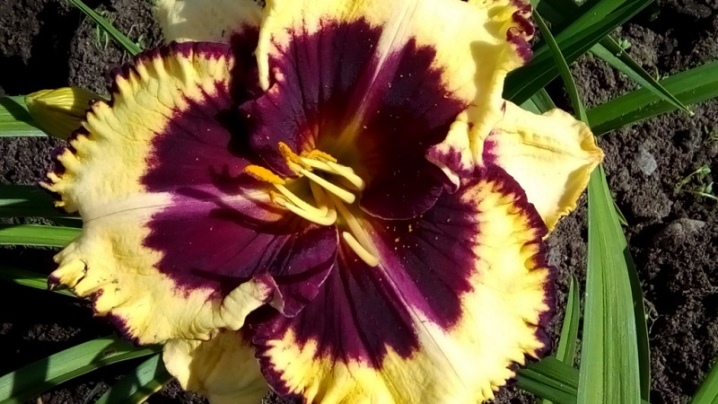
Summer Vine
A very popular Krasodnev variety, bred in 1973. Flowers are 14-15 centimeters in diameter. The height of an adult plant reaches 60 centimeters. The color of the flowers is wine-pink, with a bright yellow heart. Flowering time - July-August.

Black Stockings
Very expressive, highly decorative, re-flowering variety, resistant to low temperatures. The average height of an adult plant reaches 65 centimeters. The flowers are 14-15 centimeters in diameter. The color of the flowers is deep burgundy, with a bright yellow core.

"El desperado"
An attractive frost and drought tolerant variety of daylilies. The height of the bush reaches 60-70 centimeters. Flowers range in size from 13 to 15 centimeters in diameter. The petals are large, two-colored, with corrugated edges. The color of the flowers is sunny yellow, with a purple-red core and a yellow-green throat.
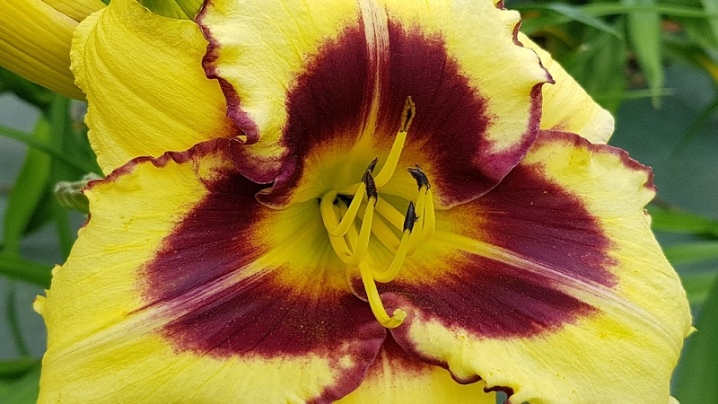
"Golden Zebra"
Variegated (variegated) medium-sized variety, which is especially popular with landscape designers. A distinctive characteristic of these plants is the unusual white-green color of the leaves. In combination with the large apricot-yellow flowers that bloom in June-July, the striped leaves give the Golden Zebra daylilies a very catchy and showy look.
The variety is considered relatively unpretentious and hardy.
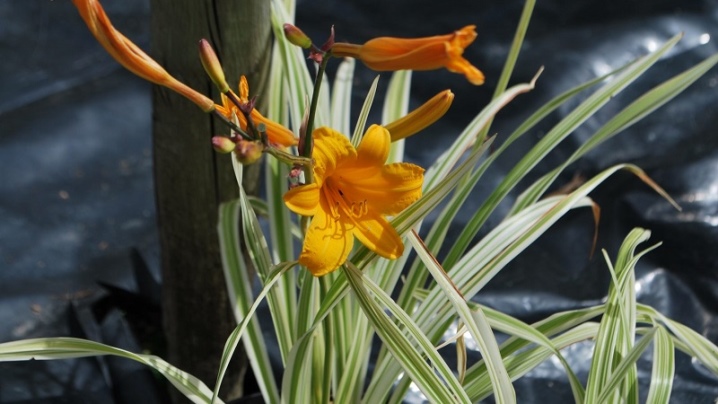
"Mini Stella"
Low-growing variety of foreign selection. The height of an adult plant reaches 30-35 centimeters. The size of the flowers is 3-4 centimeters in diameter. Flowers - fragrant, deep yellow, bell-shaped. Plants quickly form neat bushes, grow quickly and bloom profusely. They enter the flowering phase in the second half of summer.
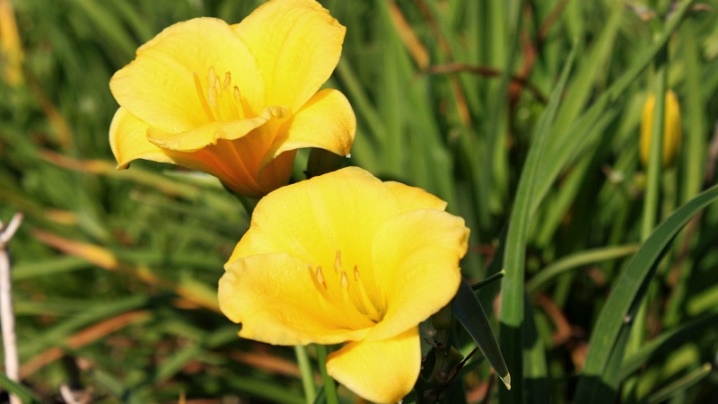
"Blue Nocturne"
A relatively young and unusually beautiful variety with flowers of an original color. The height of the peduncles is about 75 centimeters. Flowers reach 15 centimeters in diameter. The main color of flowers is dark lilac with a raspberry tint, the center is lilac-blue or lilac-blue with a yellow core. The edges of the petals are strongly corrugated, decorated with a yellow-green edging.
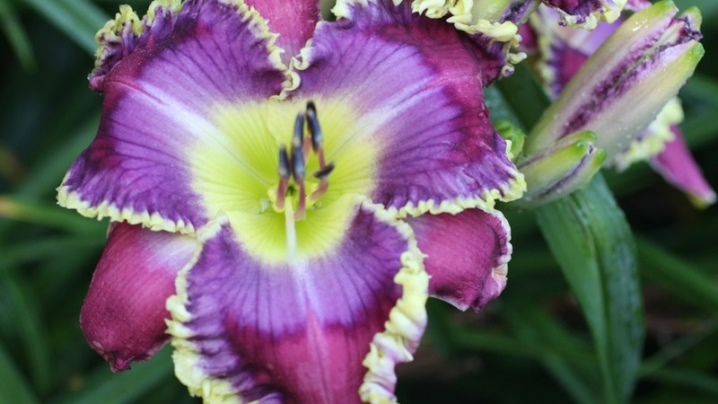
Daylily small
A species of perennials of the described genus, found in the wild in the Far East, as well as in the territories of Western and Eastern Siberia. Used by many gardeners in the design of backyard territories. The plant forms a low (up to 60 centimeters) compact bush with narrow drooping leaves. The flowers are small, sunny yellow, reaching 7-8 centimeters in diameter, have a pleasant aroma.
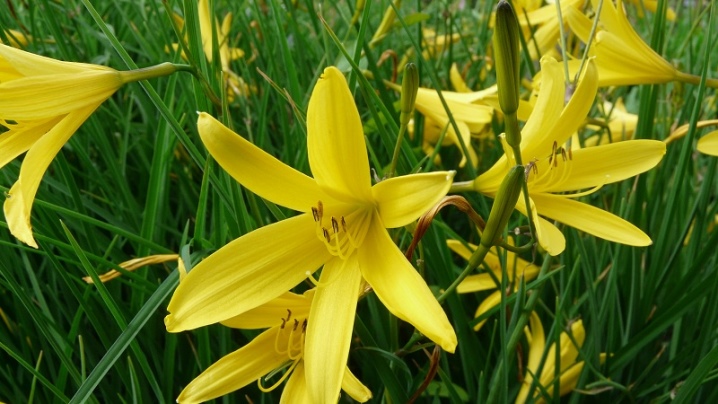
Krasodnev lemon yellow
A wild flowering herbaceous perennial found in China, Japan and Korea. Plant height can reach 90-100 centimeters. Flowers - large, very fragrant, rich lemon-yellow color. The flowering period is May-August.
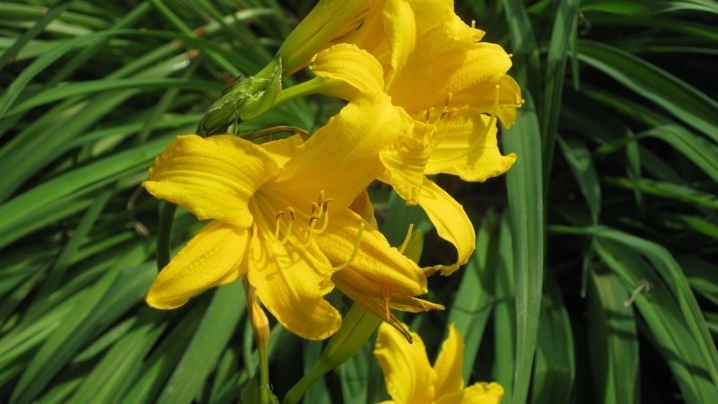
Flowering time
Depending on the timing of flowering, it is customary to distinguish daylilies:
- very early (flowering in early June);
- early flowering (second half of June);
- medium early (end of June - first half of July);
- medium (second half of July - first half of August);
- medium late (second half of August);
- late (end of August);
- very late (September and later).
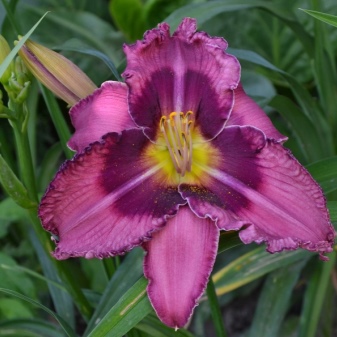

Plants of the latter category, whose flowering occurs in autumn, are usually not grown in the middle lane. With the arrival of early autumn frosts, such daylilies simply do not have time to enter the flowering phase.
It is customary to classify these flowering perennials by the type of flowering. Depending on what time of day the buds open at Krasnodnev, there are:
- plants with a daytime flowering type (flowers open in the morning and fade in the evening);
- plants with nocturnal type of flowering (flowers bloom in the late afternoon, persist overnight and fade by morning).
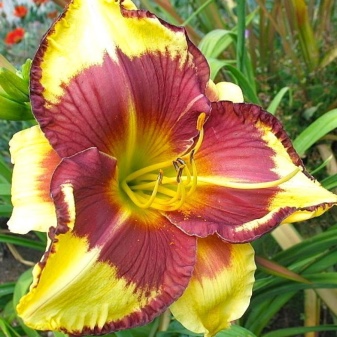
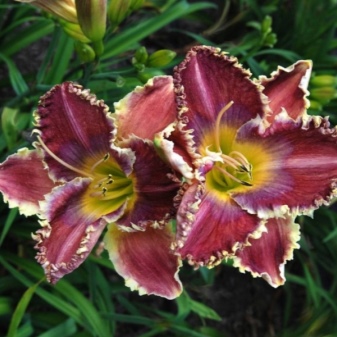
There are also varieties of daylilies (long-flowering), the type of flowering of which is called extended. Flowers of such plants can bloom both at night and during the day. At the same time, they begin to fade not earlier than 15-16 hours after the full opening of the bud. The average flowering time of modern daylilies varies from 20 to 60 days. The duration and timing of flowering depend on the varietal characteristics of the plants.
There are known varieties of daylilies that can bloom almost continuously for several months. As an example, we can cite the popular dwarf variety Stella de Oro, which delights with numerous bright yellow flowers from late spring to autumn.
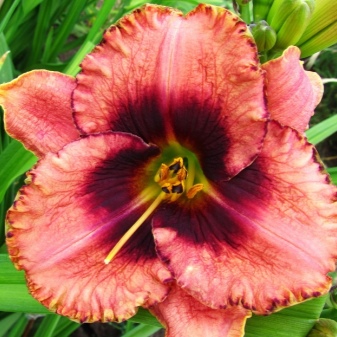

We take into account the climatic zone
Experienced florists are well aware that when choosing and buying hybrid krasodnev, it is extremely important to take into account the climatic features of their area. So, for many demanding and capricious plants, the harsh and frosty winters of the northern regions and some regions of the middle zone pose a serious threat. In such climatic zones, evergreen and some semi-evergreen hybrids inevitably freeze out or are severely damaged by frost and subsequently become seriously ill.
Experienced growers recommend using only frost-resistant plant varieties with early or medium flowering periods for growing in areas with an unstable and / or unfavorable climate.Hardy daylily varieties like Pardon me, Frans Hals, Strawberry candy can be cited as examples.
These varieties have proven themselves well when grown in regions with difficult climatic conditions - in the Moscow region, in the Leningrad region, in the Urals.


For southern regions with a mild warm climate, evergreen and semi-evergreen hybrids are optimal. Many daylilies of these groups are able to tolerate small and short night frosts. However, it should be borne in mind that when the temperature drops below 0 °, the peduncles of such plants die.
Experienced flower growers recommend giving preference to varieties and hybrids adapted to local climatic conditions when choosing daylilies. The purchase of rare and exotic hybrid krasodnev for further cultivation in areas with difficult climates is a rather risky decision. Usually, such plants die in the first winter after planting, or they recover for a long time and with difficulty, recovering only by autumn, when the flowering time has already been missed.

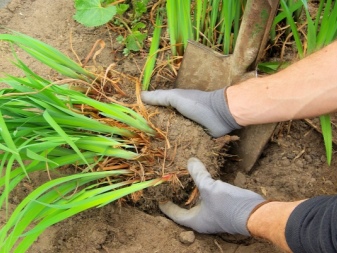
Seat selection
These unpretentious perennials prefer to grow in well-lit corners of the garden, but they are able to take root in a light shade. In heavily shaded areas, daylilies develop poorly and bloom poorly.
When choosing a place for planting krasodnev, experienced gardeners recommend taking into account the color of the flowers of the planted plants. So, varieties with light-colored flowers are best planted in sunny places, and varieties with dark colors (burgundy, purple, purple) - in shady corners of the garden, where they will be protected from burnout.
It is important to take into account that during the day the plants should be under the sun's rays for at least 5-6 hours - this will provide optimal conditions for their full development and lush flowering.


Krasodnevs love soil with a neutral or slightly acidic reaction. The soil at the landing site should be moderately loose, air and moisture permeable. Before planting, very heavy clay soils are dug up, diluting them with sand or peat. Clay or leaf humus is introduced into too light sandy soils.
When choosing a place for planting Krasnodnays, you should take into account the level of groundwater. These unpretentious plants can easily endure a short drought, but at the same time they are very painful to perceive stagnant water in the soil. When grown in places with a high level of groundwater and in flooded areas, Krasnodonov often develop fungal diseases of the root system.
Daylilies should be planted in planting pits at a distance of 60-80 centimeters from each other. The size of the interval between the planting holes depends on the variety of the planted plants and, accordingly, the size of their bushes in adulthood.
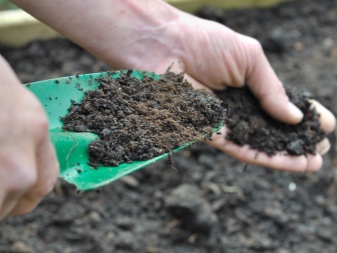
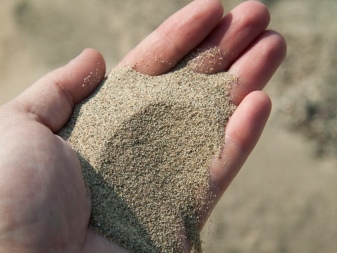
Landing rules
Daylilies are planted in open ground after a little preparation. At this stage, the roots of plant seedlings are carefully examined, dead, damaged or diseased fragments are removed using a sharp scalpel or pruner. Places of cuts are treated with charcoal powder.
The leaves of the plants are cut with pruning shears or garden shears, leaving only the lower part of them 18-20 centimeters high. This procedure is carried out to stimulate the growth of the green mass of seedlings after planting.
If the roots of the plants have had time to dry out strongly during the preparation, before planting, the seedlings must be soaked for 3-4 hours in a solution of a growth stimulator. This procedure will allow young plants to quickly take root in a new place.
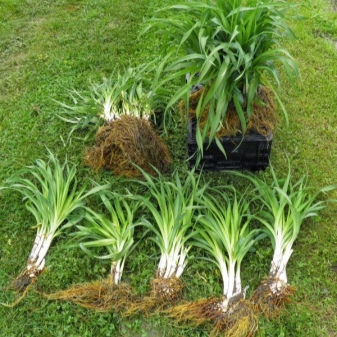

In parallel with the preparation of seedlings, the arrangement of planting pits with a depth of at least 30 centimeters is carried out. On heavy and dense soils, it is recommended to equip pits 1.5-2 times larger than the diameter of the root ball.
To fill the holes, it is advisable to use a fertile and loose soil mixture consisting of peat, leaf humus, garden soil and sand. Additionally, it is recommended to add fertilizers containing phosphorus and potassium to the soil mixture.
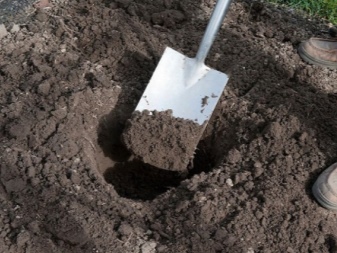
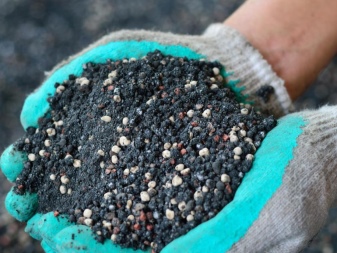
Planting seedlings is carried out as follows:
- a small layer of drainage is laid at the bottom of the planting pit and a nutritious soil mixture is poured, forming a mound out of it;
- holding the seedling by the root collar, place it vertically in the hole, after which the roots of the plant are carefully spread over the surface of the mound;
- partially fill the planting hole with nutritious soil mixture, cover the roots, carefully tamp the earth around the seedling;
- water the plant with warm, settled water and wait for it to be completely absorbed;
- fill the hole with earth to the very top.
During planting, the degree of depth of the root collar should be monitored. It should be buried in the ground only 2-3 centimeters. Its deeper location in the ground in the future can negatively affect the development and growth of the seedling.
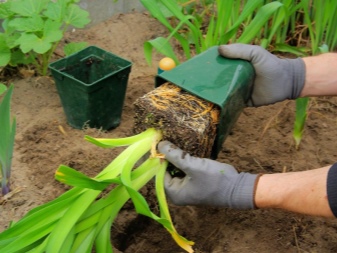
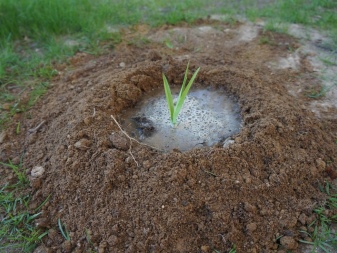
After planting, the land around the plant is carefully tamped and mulched with straw, humus or needles. A layer of mulch will preserve moisture in the soil and protect the roots of the seedlings from overheating.
It is also important to consider the recommended planting dates for daylilies. These flowering perennials should be planted in open ground in the spring or during the summer (depending on the climatic characteristics of your region). Autumn planting can threaten the fact that the plants will not have time to take root in a new place before the onset of cold weather. In particular, it is not recommended to plant beautiful days in autumn in regions with early winters.
Observations show that it takes 3-4 months for seedlings to adapt to new conditions. This time is usually enough for young daylilies to fully take root in a new place.
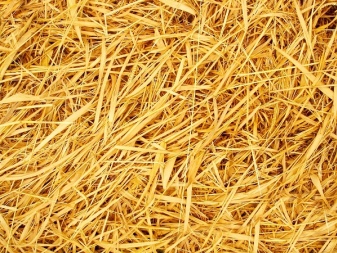
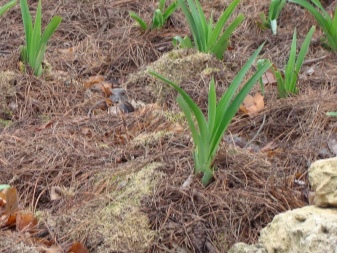
Care features
Krasodnevs are considered unassuming plants, however, for full development and high-quality flowering, they need competent care. Failure to follow or violate care recommendations often leads to a decrease in plant immunity and, as a result, a significant weakening of their health.
The main procedures that require attention when growing daylilies:
- regular watering;
- periodic feeding;
- loosening and mulching the soil.
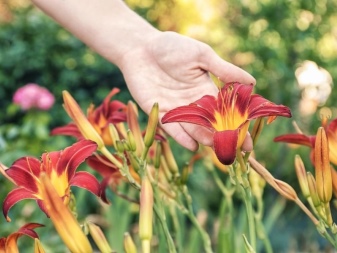
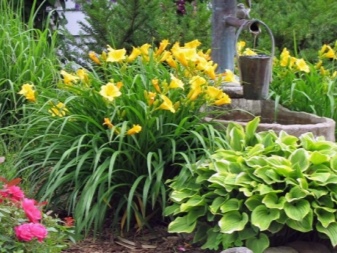
Watering
Pretty days do not need frequent watering. They tolerate slight drought and moisture deficit in the soil quite easily. However, experienced flower growers recommend avoiding too long intervals between watering, since this can negatively affect both the general condition of the plants and the quality of their flowering. Daylilies should be watered as the surface soil layer dries up. That plants need regular watering, evidenced by the slight wilting of their foliage, the reluctant formation of new buds.
It is recommended to irrigate in the early morning or in the evening using warm, settled water. The volume of water must be sufficient to completely wet the topsoil.
When watering, the stream of water should be directed under the bush, avoiding it getting on the flowers and leaves.
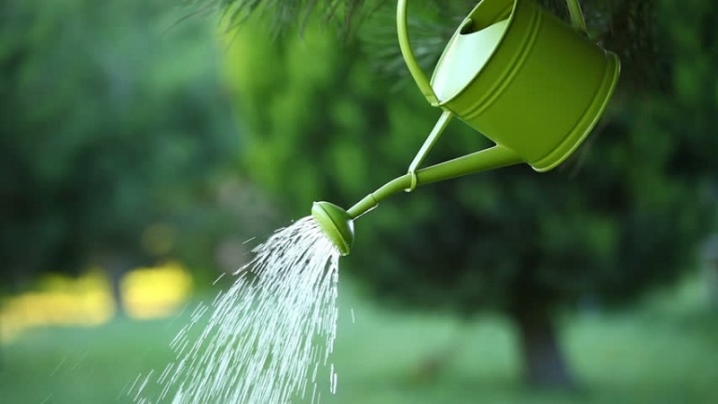
Top dressing
Timely feeding is one of the conditions on which the quality and duration of daylilies flowering depends. These perennials are usually fed twice a year - in spring and late summer. In spring, plants need to be fed during the period of active growth of green mass and budding. At this stage, it is recommended to use complex mineral fertilizing. In dry form, they are buried in the ground with a rake, distributing them evenly around the bushes. After planting the fertilizers, the plants are watered abundantly.
The second feeding is carried out during the period when the flowering of daylilies is declining. At this time, plants need to restore the energy expended on the formation of buds.For feeding at this stage, it is recommended to use complex fertilizers (Fertika Lux, Kemira Lux). Some gardeners are feeding daylilies a third time in the fall using phosphate-potassium fertilizers.
It is believed that this procedure allows plants to better prepare for the upcoming winter.

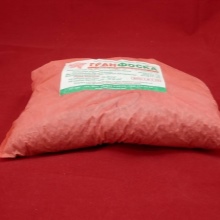
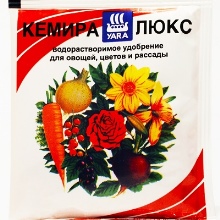
Loosening and mulching the soil
Loosening is an important agrotechnical procedure that allows you to maintain optimal air exchange in the soil. Loosening the ground around the bushes should be shallow so as not to damage the roots. After loosening, the surface of the soil around the krasodnev must be sprinkled with mulch. Mulching will prevent evaporation of soil moisture and overheating of the root system in hot weather.
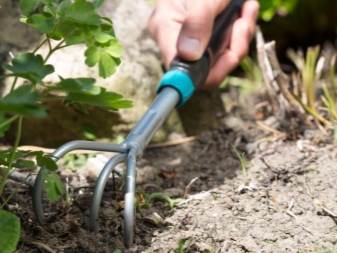
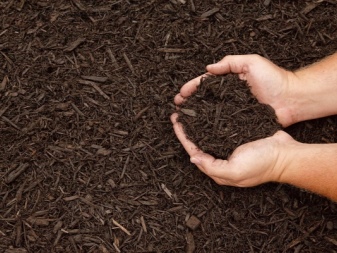
Preparing for winter
A set of procedures for preparing daylilies for winter includes the following activities:
- pruning old peduncles;
- division and planting of bushes (if necessary);
- foliage pruning (recommended for all varieties of daylilies);
- mulching the soil and sheltering plants (it is recommended to carry out in cold regions with little snowy winters).
To prevent decay of last year's foliage during the spring thaw period, daylilies must be trimmed in the fall. Pruning in autumn will rejuvenate the bushes and protect plants from pests that hibernate in dry leaves.
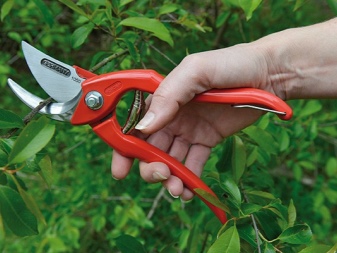

This procedure is carried out shortly before the arrival of frost. In most regions, daylilies are pruned in October or November. Plants should not be pruned earlier, as this can stimulate their active growth of new young shoots. In the course of pruning with pruning shears, the bushes are shortened to a height of 10-15 centimeters from the ground. It is impossible to cut the foliage too short, since in the future this can cause the resumption of the growth of daylilies during the spring thaw. All removed foliage and peduncles must be destroyed after pruning.
In the northern regions, krasodnevy mulch and shelter for the winter. These procedures help protect plants from freezing during winters with little or no snow. In the course of mulching, the aerial parts of the daylilies remaining after pruning are covered with needles, rotted sawdust or straw. The thickness of the mulch layer should be 5-8 centimeters. Spruce branches are laid on top of the mulch layer or the covering material is stretched.
It is recommended to equip such shelters in very cold regions with harsh winters. With the arrival of spring, the shelters are dismantled so that the plants that have started to grow do not overwhelm.
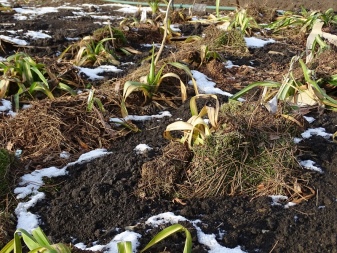
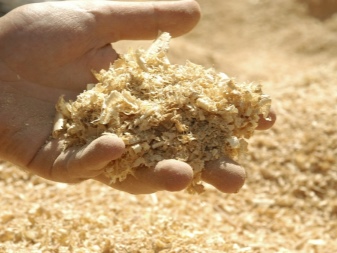
Reproduction methods
Florists propagate krasodnevy, using:
- seeds;
- sheet sockets;
- delenki (parts of the bush).
Seed method
Seed propagation is the least popular way to breed daylilies. With this method, the varietal characteristics of the plants are not preserved. Usually, this method is used by specialists in the course of breeding work on new hybrids and varieties. Since the seeds of krasodnev quickly lose their germination, they are sown directly in the harvest year before winter. During the winter period, the seeds undergo natural stratification and germinate with the arrival of heat.
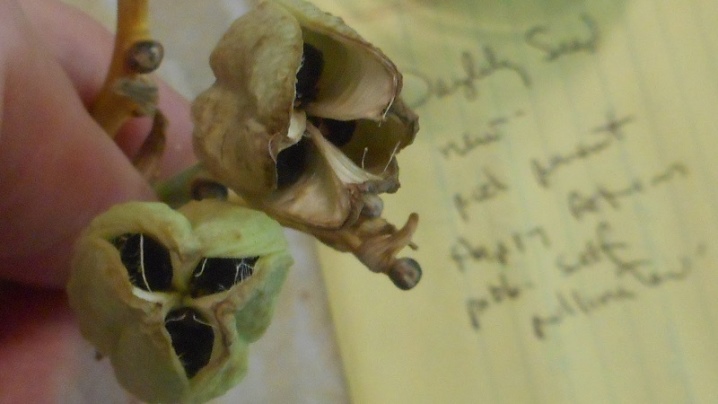
You can sow the seeds of krasodnev in the spring of next year after stratification at home. For this, the planting material before sowing is kept for 2 months in a cool place at a temperature of 2-3 °. Seeds are sown to a depth of 1-1.5 centimeters at a distance of 4-6 centimeters from each other. The first shoots usually appear within 2-3 weeks.
It should be remembered that krasodnev grown from seeds blooms only for 2-3 years. Moreover, the first flowering in him is usually weak and expressionless.
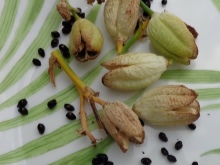
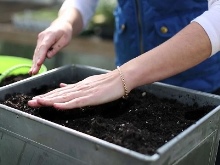
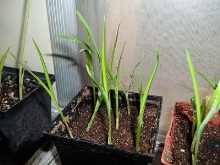
Reproduction by leaf rosettes
Daylilies can be propagated using leaf rosettes. In this case, young plants will retain all the varietal characteristics of the mother bush. Rosettes are formed on adult flower stems in the leaf axils.Separate the leaf rosettes after they have developed a sufficient number of roots. Cut off the outlet with a part of the matured stem - 4 centimeters above and 4 centimeters below the node (where the outlet is attached to the stem). The foliage on the stem cuttings is cut by about a third.
If the outlet has no roots, it is temporarily placed in a container of water. To accelerate root formation, stimulating drugs ("Epin", "Kornevin") are added to the water. Rosettes with a sufficient number of roots are planted in pots with a light soil mixture. After planting, the pots are placed in a well-lit area. Young plants are planted in open ground in spring after hardening.
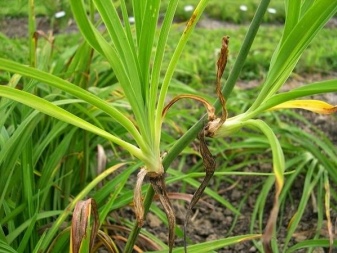
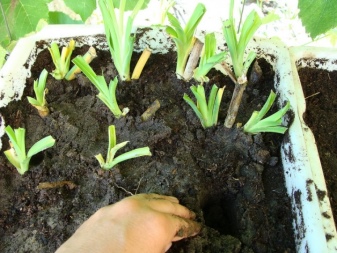
Reproduction by divisions
Most gardeners prefer to propagate beautiful flowers by dividing the bush. This method is considered to be quite simple and effective, despite the fact that it requires certain skills. This procedure is usually carried out in May or August. Pre-select the strongest, well-grown bush, which is carefully dug out of the ground. The roots of the plant are thoroughly washed, the flowering arrows are removed from the bush and the leaves are shortened.
You can divide the bush into parts with a knife or a sharp shovel. Bushes with loose roots are allowed to be separated by hand. After dividing, damaged roots and cut sites should be treated with charcoal powder.
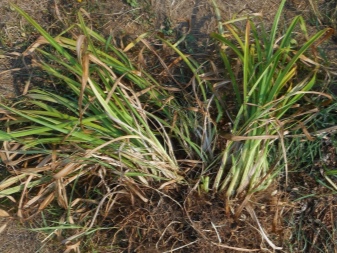

Delenki are planted on pre-prepared ridges with carefully dug earth. During the spring planting of the cuttings during the digging of the ridges, nitrogenous and phosphorus-potassium fertilizers are introduced into the soil, during the autumn planting - only phosphorus-potassium fertilizers.
When disembarking, you should not deeply deepen the delenki. Their root collar should go into the ground by 2-3 centimeters.
In the first year after planting, young plants do not need to be fertilized. Starting from the second year, the established krasodnevs are fed at least twice during the growing season.
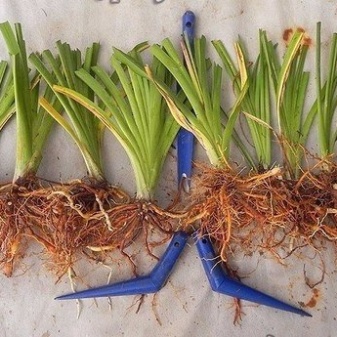

Diseases and pests
Daylilies are considered to be quite hardy plants that are rarely affected by pests and pathogens. The main reason for the weakening of the health of these perennials is a violation or non-compliance with care recommendations. Quite often krasodnevy suffer from rot of the root collar. With this disease, the leaves of the plants begin to turn yellow and wither. In some cases, a specific putrid smell may emanate from the affected parts.
To eliminate the problem, the plant must be dug out of the ground, washed the roots, removed the affected fragments from them and treated with any fungicidal preparation. Good results in the fight against rot of the root collar are obtained by the use of copper oxychloride, copper sulfate. The soil in the place where the affected plant grew should also be treated with a fungicide or potassium permanganate solution.
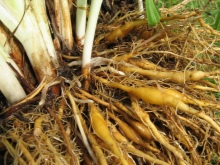


A rather dangerous disease of krasodnev is iris spot caused by a fungal infection. The development of this disease is evidenced by the appearance of brown-brown spots on the leaves of plants, gradually becoming covered with a dirty gray bloom. If untreated, the affected perennial may die. Treatment involves removing the affected foliage and treating the bush with chlorothalonil-based fungicides. Severely damaged plants need to be treated several times during the season.
Thrips are fairly well-known pests, the fight against which requires an integrated approach. These small insects feed on the juices of daylilies, greatly weakening their immunity. The fact that the plant is affected by thrips is evidenced by discoloration of foliage, deformation of buds, pallor of flower petals. To identify parasites, it is necessary to examine the lower part of the leaf plates with a magnifying glass. The fight against thrips involves the removal of the affected parts of the plant and the use of insecticidal preparations. For the treatment of the affected bushes, such effective means as "Fitoverm", "Actellik", "Karbofos" are used.
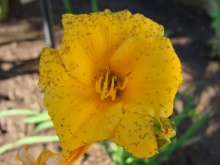
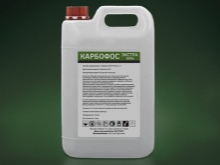
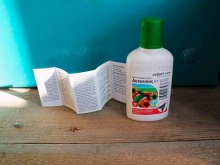
In hot and dry summers, daylilies can be attacked by spider mites. These pests, like thrips, feed on plant juices, causing yellowing and death of foliage. In cases of severe damage, the krasodnev can stop growing and even die. The fact that krasodnev is affected by a spider mite is usually indicated by discoloration and wilting of the leaves. To combat the parasite, systemic insecticidal agents are used.
One of the most dangerous pests of krasodnev is a grass bug. These are quite agile and voracious beetles, the body size of which can reach 0.5-0.6 centimeters. Serious damage to plants is caused by both adult bugs and their smaller copies - nymphs. When affected by these pests, daylilies begin to wither, shedding flower ovaries and seed pods. Their foliage and shoots are highly deformed. It is recommended to use pyrethroids to kill this parasite.
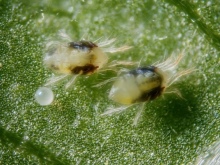
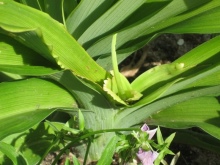
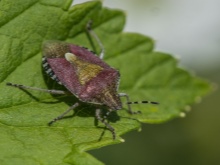
Examples in landscape design
Unpretentiousness, richness of colors, shade tolerance and winter hardiness determined the popularity of daylilies in landscape design. These beautifully flowering bush perennials are able to organically fit into the atmosphere of any garden.
Krasodnevs are equally attractive in both single and group plantings. Low-growing and border varieties of daylilies are used by designers to decorate alpine slides and rocky gardens, to create low flower beds and hedges. With their help, you can delimit the backyard territory, highlight its main functional areas, and designate the location of garden paths.
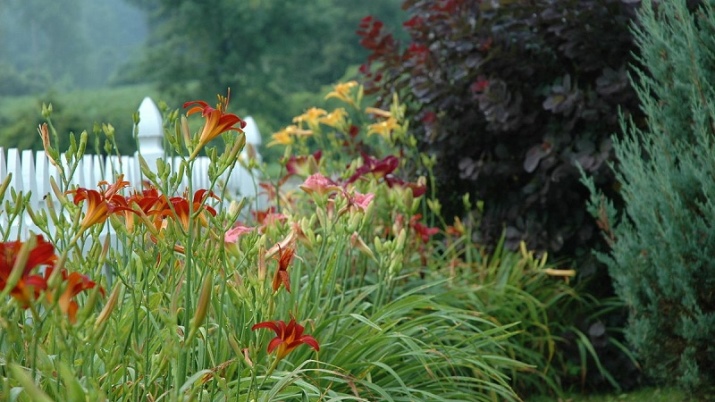
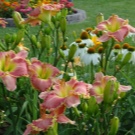


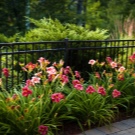

The proximity with other plants allows you to emphasize and enhance the expressiveness of flowering daylilies. However, here it should be borne in mind that these colors need an appropriate background. In this case, lawn grasses, tall conifers and deciduous crops planted in the background can be used as background plants.
Blooming daylilies, growing with hosta, tulips, daffodils, hyacinths, look very impressive.
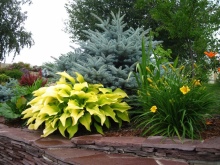
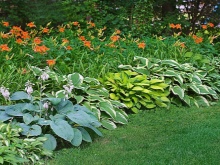
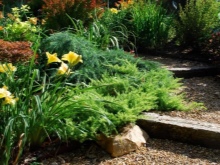
The classical scheme for arranging a flower garden with daylilies and other ornamental crops provides for the observance of a certain order when placing plants. So, tall plants are always placed in the background, medium-sized plants - in the central part of the flower garden, dwarf - in the foreground.
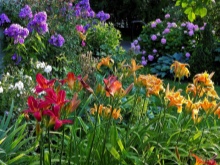
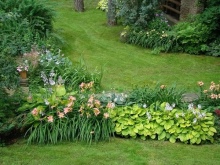
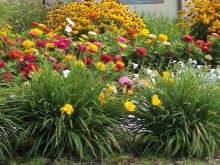
A flower bed of perennials blooming throughout the summer will fit well into the landscape of any backyard area. In the foreground of such a flower bed, you can plant undersized Gaillardia and Heliantemum, in the central part - a medium-sized daylily, a catchment and hybrid tea roses. A tall lavatera and a fan can be used as background plants.
When arranging flower beds of daylilies and other perennials, the color of flowers and foliage of plants should be taken into account. For example, daylilies with purple and red flowers will look great against a background of purple and white phlox. Purple and blue delphiniums will help emphasize the beauty of yellow-lemon beauty days. Graceful thuja with emerald needles will be a perfect backdrop for daylilies with flowers of coral shades.
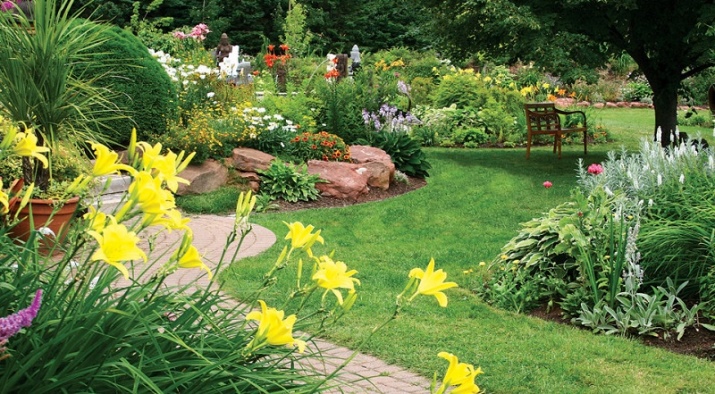


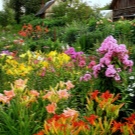
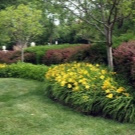

In the next video, the correct planting and reproduction of daylilies are waiting for you.




































































































The comment was sent successfully.